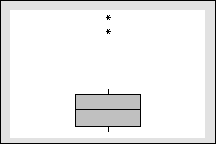
An unusually large or small observation. Outliers can have a disproportionate influence on statistical results, such as the mean, which can result in misleading interpretations. For example, a data set includes the values: 1, 2, 3, and 34. The mean value, 10, which is higher than the majority of the data (1, 2, 3), is greatly influenced by the extreme data point, 34. In this case, the mean value makes it appear that the data values are higher than they really are. You should investigate outliers because they can provide useful information about your data or process. Several explanations for outliers exist:
Often, it is easiest to identify outliers graphically. Minitab identifies
outliers on boxplots by labeling observations that are at least 1.5 times
the interquartile range (Q3

In model-fitting procedures such as regression and ANOVA, outliers are points that are not explained well by the fitted model. These points are outlying in the y-direction relative to the fitted regression line and have extreme residual values. Minitab labels observations with extreme residual values (+ 2) with an R in the table of unusual observations. You can also identify these outliers graphically, using scatterplots and residual plots, as shown below.
|
Y |
|
|
|
X |
Use diagnostic measures, such as Cook's distance or DFITS to determine whether the outlier is an influential observation. To determine the effect of the outlier on your results, run the analysis with and without the observation to see how the model changes. Note that an observation may be an outlier in one model but not in another. For example, an observation may be an outlier in a linear model but it is well-explained by a nonlinear model.